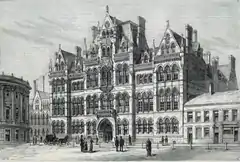Henry Fowler (engineer)
Sir Henry Fowler, KBE (29 July 1870 – 16 October 1938) was an English railway engineer, and was chief mechanical engineer of the Midland Railway and subsequently the London, Midland and Scottish Railway.
Sir Henry Fowler | |
|---|---|
| Born | 29 July 1870 |
| Died | 16 October 1938 (aged 68) |
| Nationality | English |
| Education | Mason Science College, now the University of Birmingham |
| Occupation | Engineer |
| Engineering career | |
| Discipline | Locomotive engineer |
| Institutions | Institution of Mechanical Engineers |
Biography
Fowler was born in Evesham, Worcestershire, on 29 July 1870. His father, also called Henry, was a furniture dealer, and his family were Quakers. He was educated at Prince Henry's Grammar School, Evesham (now Prince Henry's High School, Evesham), and at Mason Science College (which became the University of Birmingham) between 1885 and 1887 where he studied metallurgy. He served an apprenticeship under John Aspinall at the Lancashire and Yorkshire Railway (L&YR)'s Horwich Works from 1887 to 1891. Fowler was a elected as a Whitworth Exhibitioner in 1891.[1] He then spent four years in the Testing Department under George Hughes, whom he succeeded as head of the department.
Between 1895 and 1900 he was gas engineer of the L&YR, moving on 18 June 1900 to the Midland Railway (MR). On 1 November 1905 he became assistant works manager, being promoted to works manager two years later.
In 1908, following a visit to Sheffield, he is accredited with the formation of the Midland Railway Engineering Club which is now called the Derby Railway Engineering Society. [2]
In 1909 he succeeded Richard Deeley as chief mechanical engineer (CME) of the MR.
Between 1915 and 1919 Fowler was employed on war work and James Anderson became acting CME. During the First World War he was seconded to the Ministry of Munitions, being director of production from 1915 to 1917 and then assistant director general of aircraft production.[3] In 1919, Fowler was made a Knight Commander of the Order of the British Empire (KBE) for his contributions to the war effort.[4][5]
In 1923 on the Grouping, he was appointed deputy CME of the newly formed London, Midland and Scottish Railway (LMS), under George Hughes and became CME in October 1925. He was also invited to serve on the Government Bridge Stress Committee investigating stresses in railway-bridges, especially as regards the effects of moving loads
Along with Anderson, Fowler was responsible for the adoption by the LMS of the Midland's small engine policy. Various Midland standard types were built by the LMS, including the 4P Midland Compound 4-4-0, the 2P 4-4-0, the 4F 0-6-0, and the 3F 0-6-0T. The small engine policy resulted in frequent double-heading, as the locomotives were not powerful enough to cope with loads, and thus increased expense. Standardisation also left these standard locomotives with short-travel valves and small axle boxes, the former leading to inefficiency and the latter to frequent hot axle boxes.
In 1928, the LMS introduced the Royal Scot 4-6-0 express passenger locomotive, based on the SR Lord Nelson Class.
In another departure from the small engine policy, several 2-6-0+0-6-2 Beyer-Garratts were acquired for the Toton-Brent coal trains but interference from Derby saw these receive standard small axle-boxes and short-travel valves with the result that they were poor performers.
Fowler was not a hands-on engineer in the mould of George Jackson Churchward. Although (as was traditional) designs produced during his tenure were credited to him as "Fowler" locomotives, the majority of the work was done by his staff with minimal personal involvement from Fowler. An analogy may be made with his successor Sir William Stanier's Princess Coronation (Duchess) class, which was largely designed by LMS draughtsmen while Stanier was out of the country, although Stanier was more deeply involved in other designs during his tenure.
In 1930, Fowler became President of the Whitworth Society as successor to Mr. F. H. Livens, J.P.[6]
Fowler retired in 1933, Ernest Lemon initially taking over as CME for a short period before William Stanier was head-hunted into the job from the Great Western Railway. Stanier was to reform LMS locomotive policy.
Fowler died on 14 October 1938 at his home - Spondon Hall (now demolished), Derby. He was buried in the Nottingham Road Cemetery, Chaddesden, Derby.
Locomotive designs
The following classes of steam locomotive were introduced by Sir Henry:
- LMS Class 2P 4-4-0
- LMS Class 2F "Dock Tank" 0-6-0T
- LMS Class 3MT 2-6-2T
- LMS Class 3F "Jinty" 0-6-0T
- LMS Class 4P "Compound" 4-4-0
- LMS Class 4MT 2-6-4T
- LMS Class 4F 0-6-0
- LMS Class 7F 0-8-0
- LMS Class 6P "Patriot" 4-6-0
- LMS Class 7P "Royal Scot" 4-6-0
- LMS Garratt 2-6-0+0-6-2
- LMS 6399 Fury
- S&DJR 7F 2-8-0
References
- The Whitworth Register. The Whitworth Society. 2008. p. 87.
- Derby Railway Engineering Society 1908 - 2008 by Anthony J. Broughton, ISBN 978-0-9560468-0-2
- http://www.steamindex.com/people/fowler.htm
- "No. 31297". The London Gazette (Supplement). 15 April 1919. p. 4991.
- "No. 31457". The London Gazette (Supplement). 11 July 1919. p. 8989.
- The Whitworth Register, 2017. The Whitworth Society. 2017. pp. 36, 86.
External links
- Sir Henry Fowler at www.steamindex.com
| Government offices | ||
|---|---|---|
| Preceded by Mervyn O'Gorman |
Superintendent of the Royal Aircraft Factory 1916-1918 |
Succeeded by Sidney Smith |
| Business positions | ||
| Preceded by Richard Deeley |
Chief mechanical engineer of the Midland Railway 1909–1923 |
Succeeded by George Hughes as CME of the London, Midland and Scottish Railway |
| Preceded by George Hughes |
Chief mechanical engineer of the London, Midland and Scottish Railway 1925–1931 |
Succeeded by Ernest Lemon |
| Professional and academic associations | ||
| Preceded by Sir William Reavell |
President of the Institution of Mechanical Engineers 1927 |
Succeeded by Richard William Allen |
